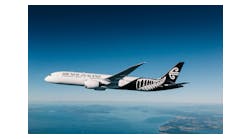Jan. 28--Will they or won't they?
After months of courting, the time is drawing near for American Airlines to decide whether to pursue a merger with US Airways, a deal that would have vast consequences for employees, travelers and the region.
With close to 100,000 employees, 1,500 aircraft and $38.7 billion in revenue combined, a marriage of American and US Airways would once again make Fort Worth home to the nation's largest airline.
More passengers would likely connect through Dallas/Fort Worth Airport, headed to other domestic destinations or across the oceans to international cities.
A beefed-up presence in New York would attract business travelers to its larger domestic network. East Coast passengers would have their pick of hubs up and down the seaboard, from Miami to Charlotte, N.C., to Washington, D.C., to New York.
Most importantly, analysts say, the new American would compete better with the two top dogs, United Airlines and Delta Air Lines.
But the proposed deal is not a slam dunk.
American's parent company, AMR Corp., and creditors are still mulling over whether to proceed with a deal while the carrier is in bankruptcy. Questions remain about how much equity in the new company would go to American creditors and US Airways shareholders.
And there's a debate over which CEO -- American's Tom Horton or US Airways' Doug Parker -- should run the company.
By unveiling its new livery and brand two weeks ago, American's management signaled that it would rather emerge from bankruptcy as a stand-alone carrier and pursue a merger later, some say.
American's unions, which hold three of the nine seats on the unsecured creditors committee, continue to support a merger, as they have since April.
And it appears that Jack Butler, the committee's general counsel, has been facilitating meetings between the carriers for the past few months.
American and US Airways declined to comment on closed-door merger discussions. Horton indicated this month that a decision could come "within weeks," but it remains unclear whether a merger will be announced by early February or a decision will be pushed into the spring. American has asked the Bankruptcy Court to extend its deadline until late April to submit a reorganization plan.
Analysts say a combined American-US Airways would be bigger and in some ways better than either airline can be on its own.
"US Airways has always been a very scrappy operator, and American has been able to reduce its costs, so it will be interesting to see what will happen if they combine," said Henry Harteveldt, a travel industry analyst at Hudson Crossing.
A combo look
In other airline mergers, flights on overlapping routes are cut and consumers end up paying higher fares because one fewer carrier is serving that market.
But analysts believe that a union between American and US Airways would make a stronger airline without negatively affecting travelers.
"This one isn't going to have much downside for consumers," said Mike Boyd, an aviation analyst at Boyd Consulting.
Their route networks in the top 25 domestic markets have little overlap, he said, and the combined carrier would probably not cut much capacity, meaning airfares would likely remain stable.
The combined company would have hubs in eight markets: New York, Chicago, Los Angeles, Miami, Dallas/Fort Worth, Charlotte, Philadelphia and Phoenix.
Analysts expect capacity cuts at Phoenix, while DFW and Charlotte would see increased traffic.
"[Those two hubs] literally blanket Delta's megahub in Atlanta, and that opens up some interesting opportunities," Harteveldt said, adding that the combined entity could increase American's already strong presence in Latin America.
Benefits for both
For American, a merger would give it more market share on the East Coast, where it has lost business in recent years to carriers like JetBlue, particularly in New York.
"US Airways still has a significant number of takeoff and landing slots at LaGuardia, so all of a sudden you can be a serious contender for business travel and you can have that significant critical mass of flying in and out of LaGuardia that maybe the two airlines on their own aren't able to offer," Harteveldt said.
While a merger would certainly strengthen the domestic network, airline researcher Bill Swelbar believes that US Airways' hubs in Charlotte and Philadelphia are the jewels in a possible combination and would increase American's north-south traffic on the East Coast.
"Charlotte is a wonderful hub," Swelbar said. "It is profitable. It is efficient and US Airways has been growing that hub to where it is performing very, very well."
For US Airways, the nation's No. 5 carrier, the merger would make it significantly bigger.
Of the four remaining legacy carriers, US Airways is the smallest in revenue, capacity and market share, and it is does not gain the full benefits of being in the Star Alliance, where United has better joint ventures with international partners.
While Wall Street analysts have applauded its efforts to improve profit margins -- the carrier posted record revenue and profit in 2012 -- investors are concerned that US Airways will lose its competitive edge as labor costs increase and revenue on its smaller network does not.
"The only way that either US Airways individually or American are going to be able to compete long term against United and Delta is to merge," Bob Herbst said.
He said a comprehensive network will allow the combined airline to win more lucrative corporate travel contracts.
Pitfalls and challenges
When United and Continental merged in 2010, the carrier became the new No. 1 in the industry. But in the two years after the merger, the transition from two airlines to one has not been smooth.
The carrier was in lengthy negotiations with its unions and had computer problems. Thousands of passengers were delayed or had flights canceled when gate agents couldn't check in customers.
With American's three unions supporting a merger with US Airways, the integration could be quick, some analysts say.
"The fact that labor appears largely on board and [US Airways and American] share a common reservation backbone suggest the typical integration pitfalls (which harassed [United] in 2012) can potentially be avoided," JPMorgan analyst Jamie Baker said in a research note this month.
The pilots unions at US Airways and American have signed memorandums of understanding that outline a new contract if the carriers merge.
However, Swelbar said that seniority integration is still a concern among pilots and that previous labor tensions between pilots and management at both carriers could hinder the merger.
"I cannot believe this will be without a lawsuit or 10 over some pilot or some group of pilots that feel they have been disenfranchised," Swelbar said.
Even if the two carriers unite, the new airline would lack meaningful market share in the fastest-growing travel market in the world: China.
American has a joint venture with Japan Airlines and its Oneworld alliance partner, Cathay Pacific, while US Airways connects to Asia through its Star Alliance partners.
"The only thing this merger will not solve and cannot solve is the Oneworld alliance, which does not have a Chinese partner," Boyd said. "Yes, the merger has L.A., but it's a rotten place to connect as a gateway to Asia."
Andrea Ahles, 817-390-7631
Twitter: @Sky_Talk
Copyright 2013 - Fort Worth Star-Telegram




